Evolution of Frictional Wear Behavior of C/C-CuNi Composites by Arc Discharge
Abstract
1. Introduction
2. Materials and Methods
2.1. Materials
2.2. Preparation of C/C-CuNi Composite
2.3. Characterization
2.4. Arc Discharge Test
3. Results
3.1. Microscopic Morphology and Physical Phase of C/C- CuNi Composite
3.2. Structural Changes Analysis of C/C-CuNi Composite After Arc Discharge
3.3. Friction Behavior and Mechanism Analysis of C/C-CuNi Composites After Arc Discharge
4. Conclusions
Author Contributions
Funding
Data Availability Statement
Conflicts of Interest
References
- Xiao, S.; Luo, Y.; Wu, J.; Zhang, C.; Rao, Y.; Wu, G.; Deng, Z.; Sykulski, J.K. An Investigation into the Characteristics of a Novel Rotatable Pantograph Catenary System for High-Speed Trains. J. Electr. Eng. Technol. 2021, 16, 1721–1730. [Google Scholar] [CrossRef]
- Zhang, W.; Shen, Z.; Zeng, J. Study on dynamics of coupled systems in high-speed trains. Veh. Syst. Dyn. 2013, 51, 966–1016. [Google Scholar] [CrossRef]
- Wang, Y.A.; Li, J.X.; Yan, Y.; Qiao, L.J. Effect of electrical current on tribological behavior of copper-impregnated metallized carbon against a Cu–Cr–Zr alloy. Tribol. Int. 2012, 50, 26–34. [Google Scholar] [CrossRef]
- Kubo, S.K.K. Effect of arc discharge on wear rate of Cu-impregnated carbon strip in unlubricated sliding against Cu trolley under electric current. Wear 1998, 216, 172–178. [Google Scholar] [CrossRef]
- Xianzh, X.; Chuanjun, T.U.; Gang, C.; Lianpu, D.; Xilun, J. Research Progress on Tribological Behavior with Current and Microstructures of Worn Surfaces of Pantograph Contact Strip. Mater. Rev. 2014, 28, 20–25. [Google Scholar]
- Ding, T.; Chen, G.X.; Wang, X.; Zhu, M.H.; Zhang, W.H.; Zhou, W.X. Friction and wear behavior of pure carbon strip sliding against copper contact wire under AC passage at high speeds. Tribol. Int. 2011, 44, 437–444. [Google Scholar] [CrossRef]
- Deng, C.; Yin, J.; Zhang, H.; Xiong, X.; Wang, P.; Sun, M. The tribological properties of Cf/Cu/C composites under applied electric current. Tribol. Int. 2017, 116, 84–94. [Google Scholar] [CrossRef]
- Xu, E.; Huang, J.; Li, Y.; Zhu, Z.; Cheng, M.; Li, D.; Zhong, H.; Liu, J.; Jiang, Y. Graphite cluster/copper-based powder metallurgy composite for pantograph slider with well-behaved mechanical and wear performance. Powder Technol. 2019, 344, 551–560. [Google Scholar] [CrossRef]
- Kim, Y.; Sathish Kumar, S.K.; Park, Y.; Kwon, H.; Kim, C.-G. High-velocity impact onto a high-frictional fabric treated with adhesive spray coating and shear thickening fluid impregnation. Compos. Part B Eng. 2020, 185, 107742. [Google Scholar] [CrossRef]
- Zhang, G.; Liu, Y.; Guo, F.; Liu, X.; Wang, Y. Friction Characteristics of Impregnated and Non-Impregnated Graphite against Cemented Carbide under Water Lubrication. J. Mater. Sci. Technol. 2017, 33, 1203–1209. [Google Scholar] [CrossRef]
- Yang, H.; Hu, B.; Liu, Y.; Cui, X.; Jiang, G. Influence of reciprocating distance on the delamination wear of the carbon strip in pantograph-catenary system at high sliding-speed with strong electrical current. Eng. Fail. Anal. 2019, 104, 887–897. [Google Scholar] [CrossRef]
- Bucca, G.; Collina, A. Electromechanical interaction between carbon-based pantograph strip and copper contact wire: A heuristic wear model. Tribol. Int. 2015, 92, 47–56. [Google Scholar] [CrossRef]
- Bucca, G.; Collina, A. A procedure for the wear prediction of collector strip and contact wire in pantograph-catenary system. Wear 2009, 266, 46–59. [Google Scholar] [CrossRef]
- Kubo, S.; Tsuchiya, H.; Kubota, Y. Application of Metal-Impregnated Carbon-Carbon Composite to Contact Strips of Pantograph of Electric Railway Vehicles. In Proceedings of the International Conference on Carbon 2008, Nagano, Japan, 13–18 July 2008. [Google Scholar]
- Zhou, W.Y.; Ran, L.P.; Peng, K.; Ge, Y.C.; Wu, H.; Yi, M.Z. Effect of Carbon/Carbon Preform Density on the Microstructure and Properties of Mo2C Interlayer-Modified Carbon/Carbon–Copper Composites for Sliding Contact Materials. Adv. Eng. Mater. 2015, 18, 277–283. [Google Scholar] [CrossRef]
- Yin, J.; Zhang, H.; Tan, C.; Xiong, X. Effect of heat treatment temperature on sliding wear behaviour of C/C-Cu composites under electric current. Wear 2014, 312, 91–95. [Google Scholar] [CrossRef]
- Yu, H.Y.; Shi, X.L.; Xu, F.M.; Tan, Y. Effect of infiltration copper or aluminium on flexural strength of C/C composite materials. Mater. Mech. Eng. 2007, 31, 61–64. [Google Scholar]
- Yin, J.; Zhang, H.; Xiong, X.; Tao, H.; Wang, P.; Deng, C. Influence of applied load on wear behavior of C/C-Cu composites under electric current. Prog. Nat. Sci. Mater. Int. 2017, 27, 192–196. [Google Scholar] [CrossRef]
- Ran, L.; Peng, K.; Yi, M.; Yang, L. Ablation property of a C/C–Cu composite prepared by pressureless infiltration. Mater. Lett. 2011, 65, 2076–2078. [Google Scholar] [CrossRef]
- Yin, J.; Zhang, H.; Bai, K.; Xiong, X.; Zhang, H.; Ma, D. Effect of carbon matrix on mechanical and tribological properties of Cf/Cu/C composites. Mater. Charact. 2020, 168, 110551. [Google Scholar] [CrossRef]
- Lloyd, J.C.; Neubauer, E.; Barcena, J.; Clegg, W.J. Effect of titanium on copper–titanium/carbon nanofibre composite materials. Compos. Sci. Technol. 2010, 70, 2284–2289. [Google Scholar] [CrossRef]
- Zhang, P.; Zhang, L.; Fu, K.; Wu, P.; Qu, X. Effects of Ni-Coated Graphite Flake on Braking Behavior of Cu-Based Brake Pads Applied in High-Speed Railway Trains. J. Tribol. 2019, 141, 081301. [Google Scholar] [CrossRef]
- Zhao, H.; Liu, L.; Hu, W.; Shen, B. Friction and wear behavior of Ni–graphite composites prepared by electroforming. Mater. Des. 2007, 28, 1374–1378. [Google Scholar] [CrossRef]
- Liao, Q.; Wei, W.; Zuo, H.; Li, X.; Yang, Z.; Xiao, S.; Wu, G. Interfacial bonding enhancement and properties improvement of carbon/copper composites based on nickel doping. Compos. Interfaces 2020, 28, 637–649. [Google Scholar] [CrossRef]
- Ouyang, H.; Ma, Y.; Gong, Q.; Li, C.; Huang, J.; Xu, Z.; Wei, B. Tailoring porous structure and graphitic degree of seaweed-derived carbons for high-rate performance lithium-ion batteries. J. Alloys Compd. 2020, 823, 153862. [Google Scholar] [CrossRef]
- Ouyang, H.; Wang, P.; Li, C.; Gao, R.; Shen, T.; Li, Y. Effect of humidity on the friction and wear behavior of C/C-CuNi composites. Diam. Relat. Mater. 2024, 146, 111144. [Google Scholar] [CrossRef]
- Weng, Y.; Yang, X.; Chen, F.; Zhang, X.; Shi, A.; Yan, J.; Huang, Q. Effect of CVI SiC content on ablation and mechanism of C/C-SiC-ZrC-Cu composites. Ceram. Int. 2022, 48, 7937–7950. [Google Scholar] [CrossRef]
- Wang, S.; Yin, J.; Xiefeng, M.; Tang, L.; Xiong, X.; Zhang, H.; Wen, Q.; Ma, D.; Zuo, J. Microstructure and ablation behaviour of C/C-SiC-ZrC-Cu composites prepared by reactive melt infiltration. Mater. Today Commun. 2024, 38, 108389. [Google Scholar] [CrossRef]
- Dong, Z.; Liu, B.; Hu, D.; Fu, Q. Low-temperature preparation of C/C-W-Cu composites with enhanced particle impact and ablation resistance. J. Alloys Compd. 2025, 1010, 177605. [Google Scholar] [CrossRef]
- Yuan, H.; Wang, C.; Zhang, S.; Lin, X. Effect of surface modification on carbon fiber and its reinforced phenolic matrix composite. Appl. Surf. Sci. 2012, 259, 288–293. [Google Scholar] [CrossRef]
- Cui, L.; Luo, R.; Wang, L.; Luo, H.; Deng, C. Novel copper-impregnated carbon strip for sliding contact materials. J. Alloys Compd. 2018, 735, 1846–1853. [Google Scholar] [CrossRef]
- Li, C.; Li, G.; Ouyang, H.; Huang, J.; Hou, X. Microstructure and properties of C/C–ZrC composites prepared by hydrothermal deposition combined with carbothermal reduction. J. Alloys Compd. 2018, 741, 323–330. [Google Scholar] [CrossRef]
- Zhai, D.; Du, H.; Li, B.; Zhu, Y.; Kang, F. Porous graphitic carbons prepared by combining chemical activation with catalytic graphitization. Carbon 2011, 49, 725–729. [Google Scholar] [CrossRef]
- Malard, L.M.; Pimenta, M.A.; Dresselhaus, G.; Dresselhaus, M.S. Raman spectroscopy in graphene. Phys. Rep. 2009, 473, 51–87. [Google Scholar] [CrossRef]
- Guo, P.; Su, L.; Jia, S.; Ni, Z.; Dai, Z.; Guo, J.; Wang, X.; Peng, K.; Wang, H. Strong SiC@Carbon nanowire aerogel metamaterials for efficient electromagnetic interference shielding. Carbon 2024, 229, 119492. [Google Scholar] [CrossRef]
- Xue, C.; Yang, F.; Wang, E.; Feng, L.; Du, X.; Hao, X.; Li, X. Nanosized graphitic carbon with balanced micro/mesoporosity for robust supercapacitor with superior volumetric capacitance and cyclic performance. Electrochim. Acta 2018, 271, 406–416. [Google Scholar] [CrossRef]
- Zhang, Y.; Chen, L.; Meng, Y.; Xie, J.; Guo, Y.; Xiao, D. Lithium and sodium storage in highly ordered mesoporous nitrogen-doped carbons derived from honey. J. Power Sources 2016, 335, 20–30. [Google Scholar] [CrossRef]
- Zhao, L.; Zhao, X.; Burke, L.T.; Bennett, J.C.; Dunlap, R.A.; Obrovac, M.N. Voronoi-Tessellated Graphite Produced by Low-Temperature Catalytic Graphitization from Renewable Resources. ChemSusChem 2017, 10, 3409–3418. [Google Scholar] [CrossRef] [PubMed]
- Zhou, F.; Chen, X.; Liu, P. Arc ablation behavior and mechanism of copper matrix composites reinforced with CNTs and Al2O3 particles. Mater. Today Commun. 2025, 46, 112584. [Google Scholar] [CrossRef]
- Yudasaka, M.; Tasaka, K.; Kikuchi, R.; Ohki, Y.; Yoshimura, S.; Ota, E. Influence of chemical bond of carbon on Ni catalyzed graphitization. J. Appl. Phys. 1997, 81, 7623–7629. [Google Scholar] [CrossRef]
- Guizani, C.; Haddad, K.; Limousy, L.; Jeguirim, M. New insights on the structural evolution of biomass char upon pyrolysis as revealed by the Raman spectroscopy and elemental analysis. Carbon 2017, 119, 519–521. [Google Scholar] [CrossRef]
- Li, C.; Li, K.; Li, H.; Zhang, Y.; Liu, L.; Sun, C. Microstructure and thermal conductivity of carbon/carbon composites containing zirconium carbide. J. Mater. Sci. 2013, 48, 7568–7573. [Google Scholar] [CrossRef]
- Ribeiro, H.; Schnitzler, M.C.; da Silva, W.M.; Santos, A.P. Purification of carbon nanotubes produced by the electric arc-discharge method. Surf. Interfaces 2021, 26, 101389. [Google Scholar] [CrossRef]
- Mondal, S.; Datta, A. Correlating Negative Thermal Expansion and Thermal Conductivity in Two-dimensional Carbon-based Materials. Phys. Chem. Chem. Phys. 2024, 26, 29568–29576. [Google Scholar] [CrossRef]
- Tao, K.; Li, P.; Kang, L.; Li, X.; Zhou, Q.; Dong, L.; Liang, W. Facile and low-cost combustion-synthesized amorphous mesoporous NiO/carbon as high mass-loading pseudocapacitor materials. J. Power Sources 2015, 293, 23–32. [Google Scholar] [CrossRef]
- Xu, H.; Ye, T.; Zhang, X.; Lu, L.; Xiong, W.; Zhu, Y. Insights into the adsorption mechanism of N-thiourea-maleamic acid on chalcopyrite surface in the flotation separation of Cu-Mo sulfide ores. J. Mol. Liq. 2022, 350, 118554. [Google Scholar] [CrossRef]
- Wang, Y.; Zhang, M.; Wang, Y.; Zhang, G.; Lu, Z. Influence of currents on tribological behavior of diamond-like carbon films. Appl. Phys. A 2020, 126, 248. [Google Scholar] [CrossRef]
- Dai, H.-C.; Shen, F.; Li, Y.-H.; Ke, L.-L. Sliding Electrical Contact Model Considering Frictional and Joule Heating. Acta Mech. Solida Sin. 2024, 37, 823–836. [Google Scholar] [CrossRef]




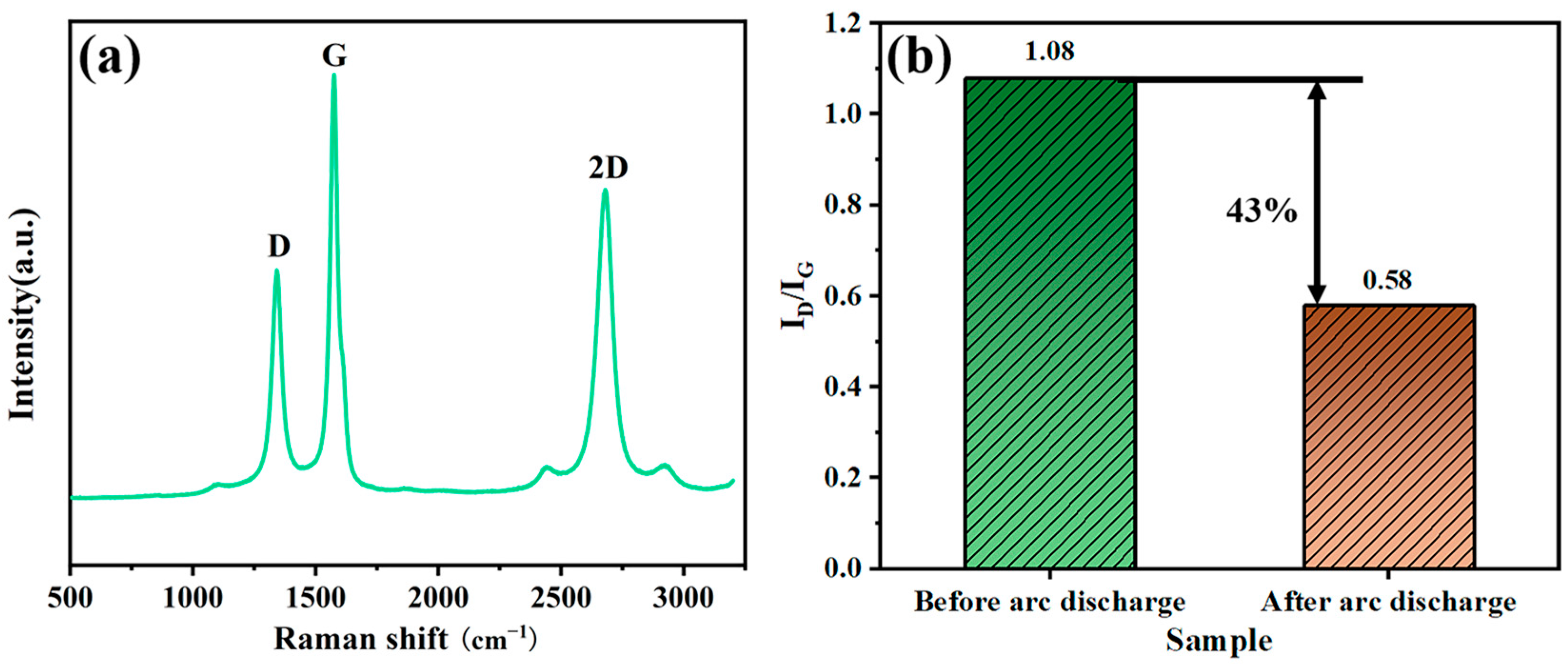


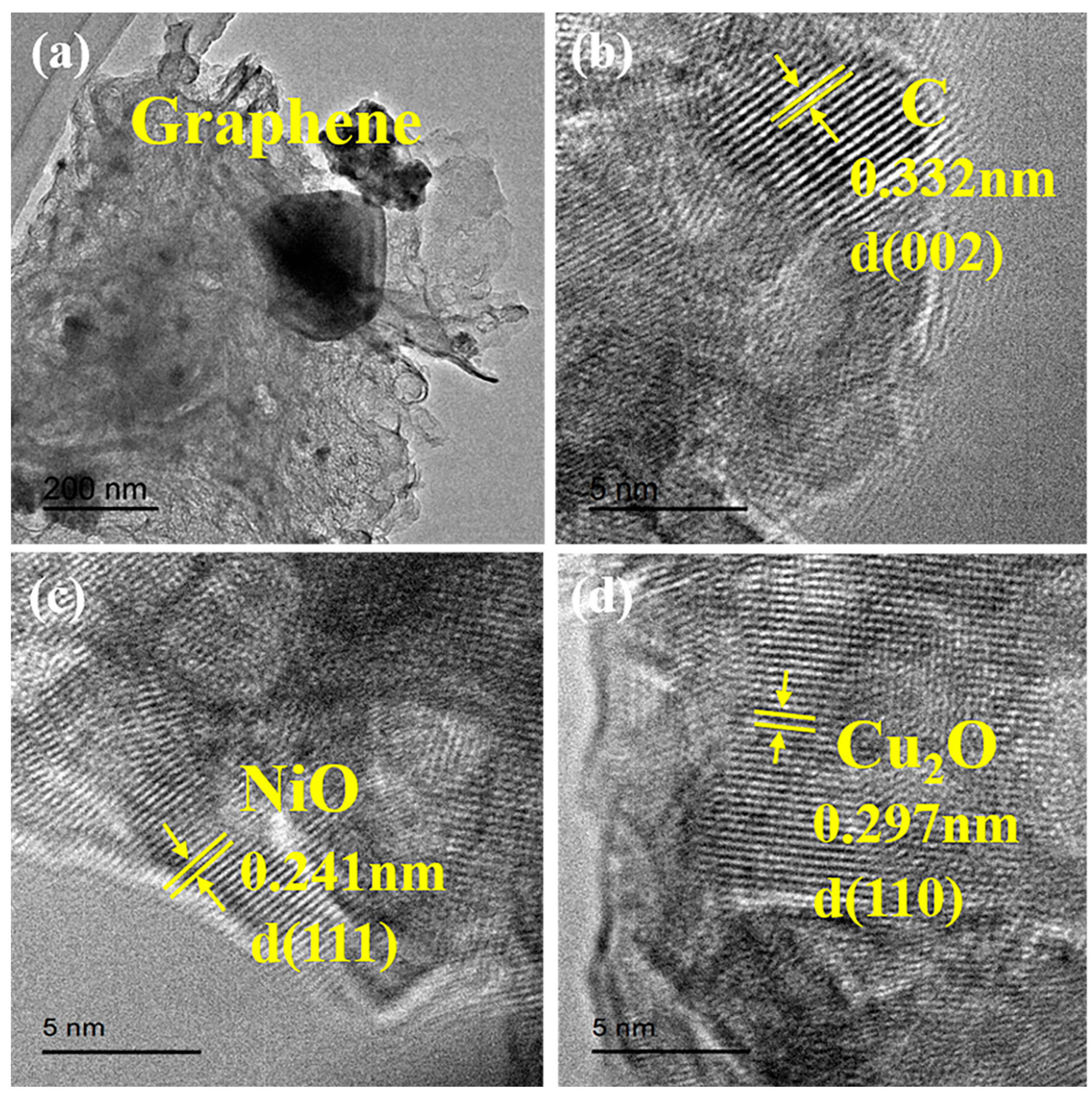
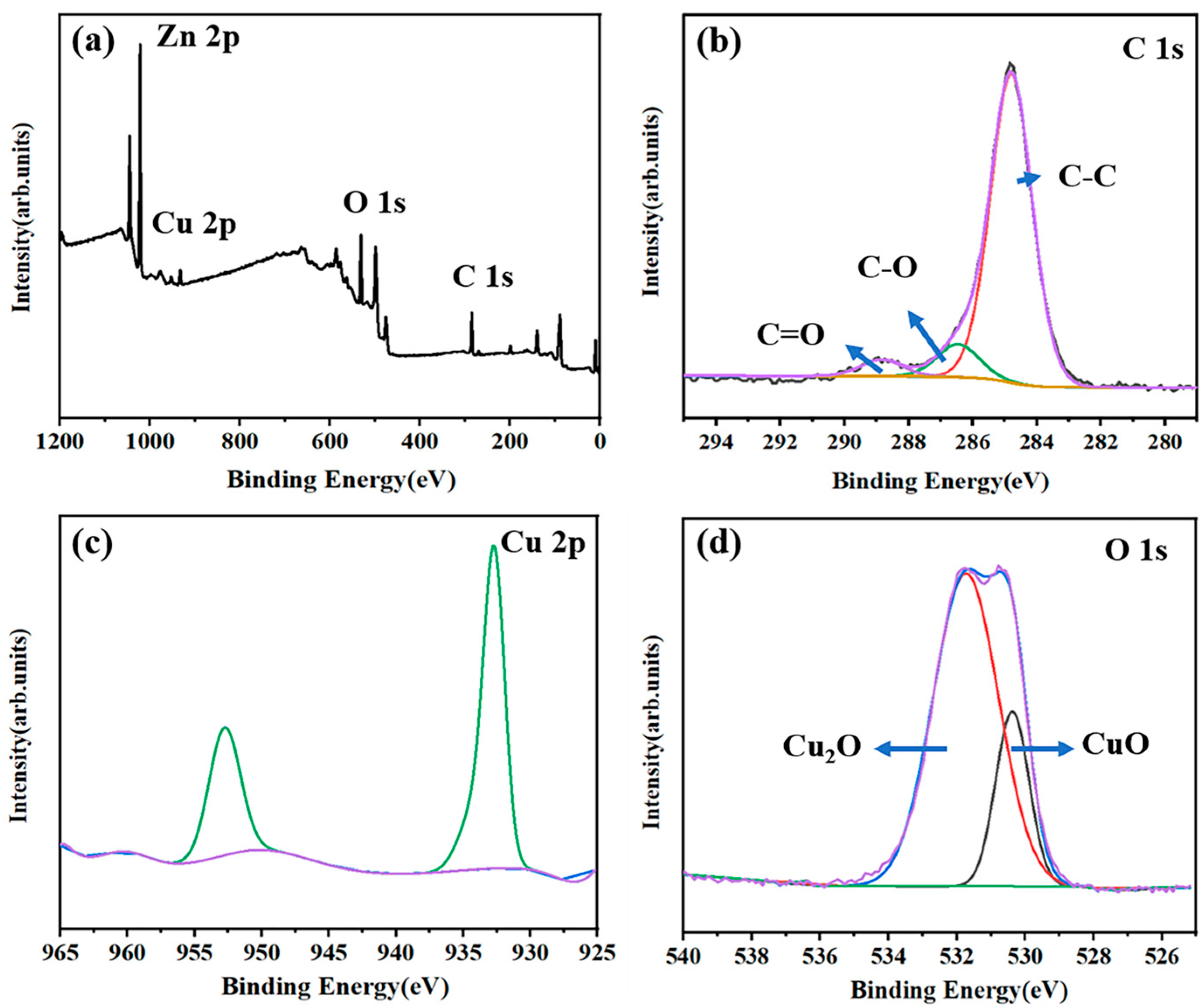

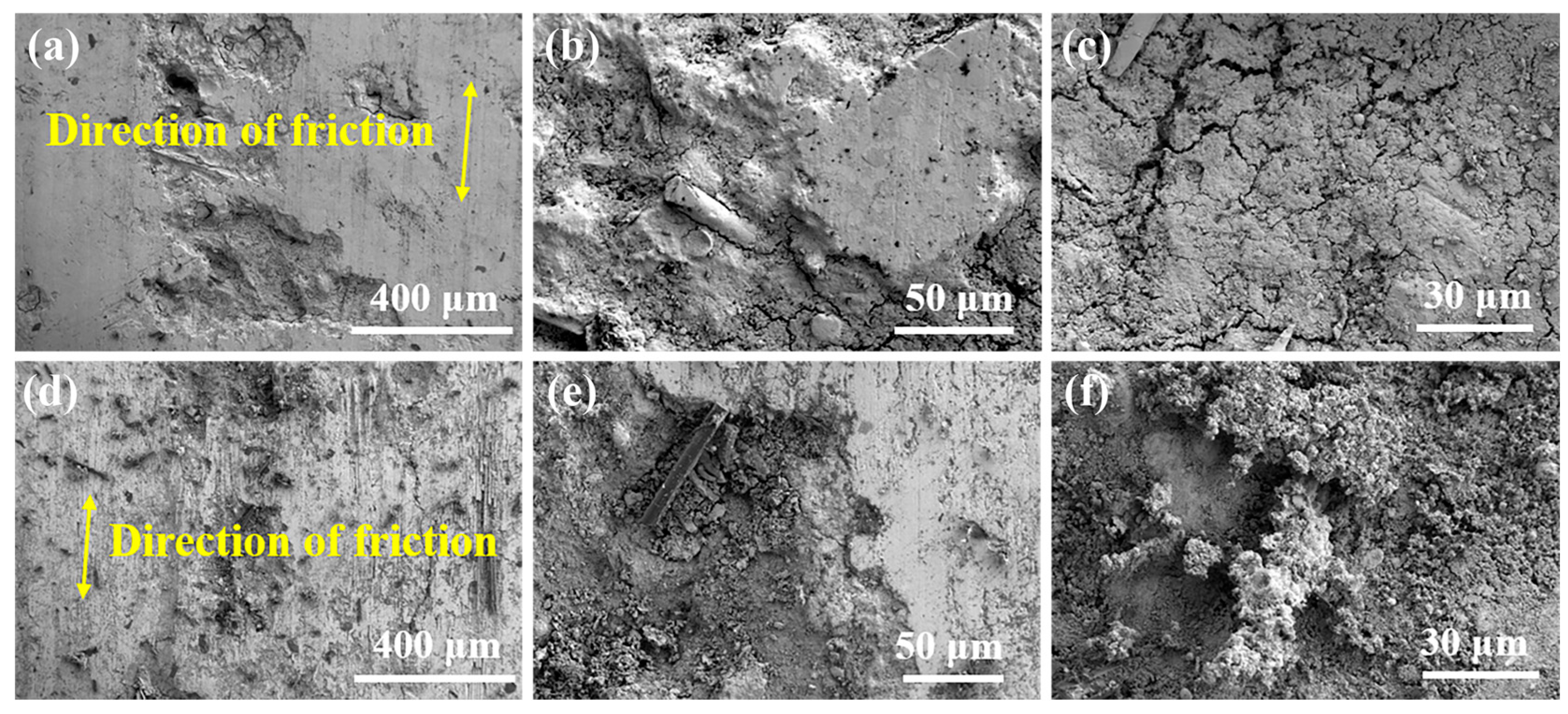
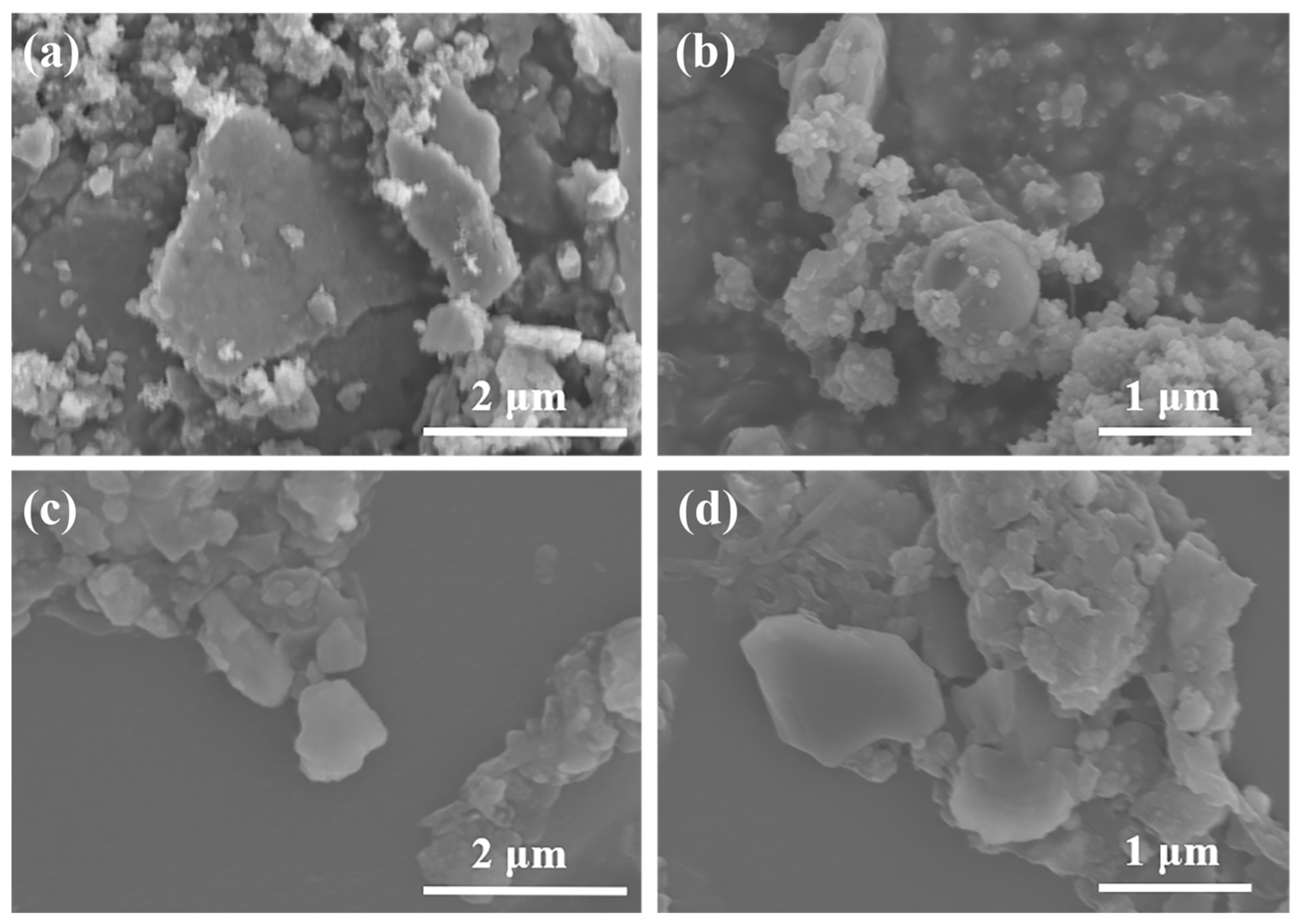

| Sample | Electric Arc Discharge Points/cm2 |
|---|---|
| CN-0 | 0 points |
| CN-5 | 5 points |
| CN-10 | 10 points |
Disclaimer/Publisher’s Note: The statements, opinions and data contained in all publications are solely those of the individual author(s) and contributor(s) and not of MDPI and/or the editor(s). MDPI and/or the editor(s) disclaim responsibility for any injury to people or property resulting from any ideas, methods, instructions or products referred to in the content. |
© 2025 by the authors. Licensee MDPI, Basel, Switzerland. This article is an open access article distributed under the terms and conditions of the Creative Commons Attribution (CC BY) license (https://creativecommons.org/licenses/by/4.0/).
Share and Cite
Liu, X.; Zhang, Y.; Wu, H.; Zhang, D.; Liu, J.; Ouyang, H. Evolution of Frictional Wear Behavior of C/C-CuNi Composites by Arc Discharge. Lubricants 2025, 13, 282. https://doi.org/10.3390/lubricants13070282
Liu X, Zhang Y, Wu H, Zhang D, Liu J, Ouyang H. Evolution of Frictional Wear Behavior of C/C-CuNi Composites by Arc Discharge. Lubricants. 2025; 13(7):282. https://doi.org/10.3390/lubricants13070282
Chicago/Turabian StyleLiu, Xizong, Yulei Zhang, Heng Wu, Dongsheng Zhang, Jiaqi Liu, and Haibo Ouyang. 2025. "Evolution of Frictional Wear Behavior of C/C-CuNi Composites by Arc Discharge" Lubricants 13, no. 7: 282. https://doi.org/10.3390/lubricants13070282
APA StyleLiu, X., Zhang, Y., Wu, H., Zhang, D., Liu, J., & Ouyang, H. (2025). Evolution of Frictional Wear Behavior of C/C-CuNi Composites by Arc Discharge. Lubricants, 13(7), 282. https://doi.org/10.3390/lubricants13070282





